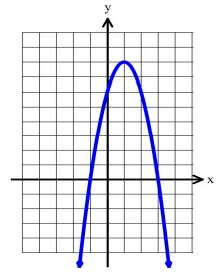TRANSFORMATION OF QUADRATIC FUNCTIONS WORKSHEET
Problem 1 :
What are the transformations on the function
y = 2x2 + 4x - 15
Problem 2 :
The function from y = 2x2 + 20x - 22, is shifted 3 units up and 2 to the left. What is the new equation for y?
Problem 3 :
Translate the graph of f(x) = x2 four (4) units to the left, three (3) units up and stretch the graph by a factor of 2. Which of the following is the function after the transformations?
A. f(x) = 1/2(x + 4)2 + 3 B. f(x) = 1/2(x - 3)2 - 4
C. f(x) = 2(x + 4)2 + 3 D. f(x) = 2(x - 3)2 - 4
Problem 4 :
Translate y = x2 + 2x + 1 four units to the right and 1 unit down. What is the equation of the new function, in vertex form?
Problem 5 :
The graph f(x) = x2 has a vertical compression of by a factor of 1/5 and is shifted down 8. What is the equation of the function after the transformation?
Problem 6 :
Describe in words how the graph of g(x) = -3(x + 5)2 would be transformed from the parent function f(x) = x2.
Problem 7 :
Given the graph of h(x), fill in the requested information:

Transformations:
Vertex:
y-intercept:
Roots:
Domain:
Range:
Max/Min:
Problem 8 :
Compare the functions, f(x) and g(x), and explain how the graph of f(x) = x2 - 4x + 4 is related to the graph of g(x) = x2 - 4x - 2.
A. f(x) is vertically stretched to make g(x)
B. f(x) is translated 6 units left to make g(x)
C. f(x) is translated down 6 units to make g(x)
D. f(x) is compressed vertically to make g(x)
Solution :
1. Answer :
y = 2x2 + 4x - 15
= 2(x2 + 2x) - 15
= 2[(x + 1)2 - 1] - 15
= 2(x + 1)2 - 2 - 15
= 2(x + 1)2 - 17
h = -1 and k = -17
Parent function y = x2
Describing transformation :
Vertically stretch a factor of 2, moving the curve left 1 units and down 17 units.
2. Answer :
y = 2x2 + 20x - 22
y = x2 + (20/2)x - (22/2)
= x2 + 10x - 11
= x2 + 2(x)(5) - 11
= x2 + 2(x)(5) + 52 - 11 - 52
y = (x + 5)2 - 36
3 units up and 2 units left.
y = (x + 5 - 2)2 - 36 + 3
y = (x + 3)2 - 33
3. Answer :
Move the vertex to (h, k) equals (-4, 3) and stretch from that point in the vertical direction by 2. So, a = 2
y = a(x - h)2 + k
Stretch factor of 2, 4 units left and 3 units up.
a = 2, h = -4 and k = 3
= 2(x - (-4))2 + 3
y = 2(x + 4)2 + 3
So, option (C) is correct.
4. Answer :
y = x2 + 2x + 1
4 units right and 1 unit down. So, +4 and -1
Converting the given equation in the form
y = a(x - h)2 + k
= x2 + 2 x (1) + 12 - 12 + 1
= (x + 1)2 - 1 + 1
y = (x + 1)2
Applying the required changes :
y = (x + 1 - 4)2 - 1
y = (x - 3)2 - 1
So, vertex form is y = (x - 3)2 - 1.
5. Answer :
Move the vertex to (h, k) equals (0, -8) and stretch from that point in the vertical direction by 1/5. So, a = 1/5
y = a(x - h)2 + k
y = 1/5(x - 0)2 - 8
f(x) = 1/5x2 - 8
6. Answer :
y = a(x - h)2 + k
g(x) = -3(x + 5)2
= -3(x - (-5))2
Describing the transformation :
- Vertically stretched with the factor of 3
- Reflection across x-axis
- Shifting the graph 5 units left.
7. Answer :
Transformations:
Since the parabola opens down, reflection across x-axis happened. Moving the graph 1 unit right and 8 units up.
Vertex:
Vertex (h, k) = (1, 8)
y-intercept:
y-intercept = (0, 6)
Roots:
Roots = (-1, 0) and (3, 0)
Domain:
All real number.
x € R
Range:
{y| y ≤ 8}
Max/Min:
Max = 8
8. Answer :
f(x) = x2 - 4x + 4
g(x) = x2 - 4x - 2
Converting into vertex form
|
f(x) = x2 - 4x + 4 f(x) = (x - 2)2 - 22 + 4 = (x - 2)2 - 4 + 4 f(x) = (x - 2)2 |
g(x) = x2 - 4x - 2 = (x - 2)2 - 22 - 2 = (x - 2)2 - 4 - 2 g(x) = (x - 2)2 - 6 |
-6, so the graph has been shifted 6 units down.
Recent Articles
-
Finding Range of Values Inequality Problems
May 21, 24 08:51 PM
Finding Range of Values Inequality Problems -
Solving Two Step Inequality Word Problems
May 21, 24 08:51 AM
Solving Two Step Inequality Word Problems -
Exponential Function Context and Data Modeling
May 20, 24 10:45 PM
Exponential Function Context and Data Modeling